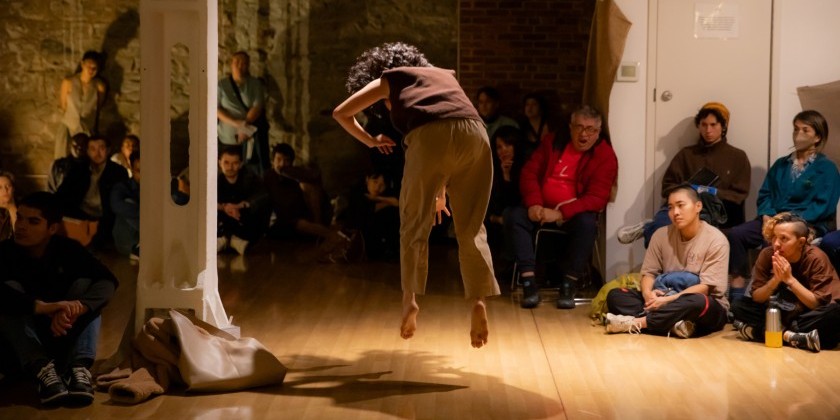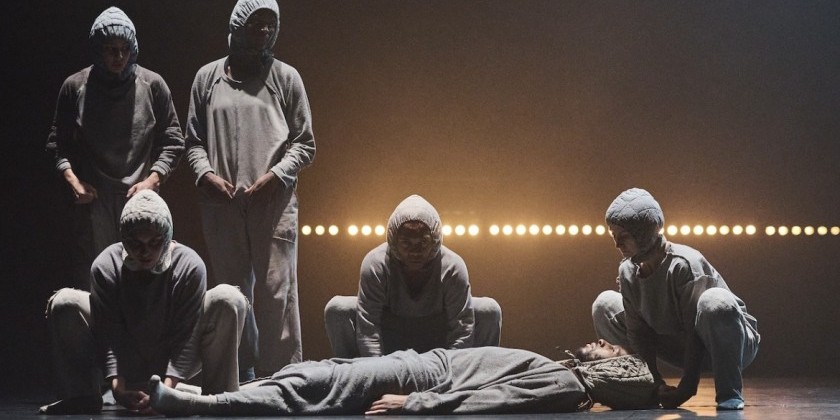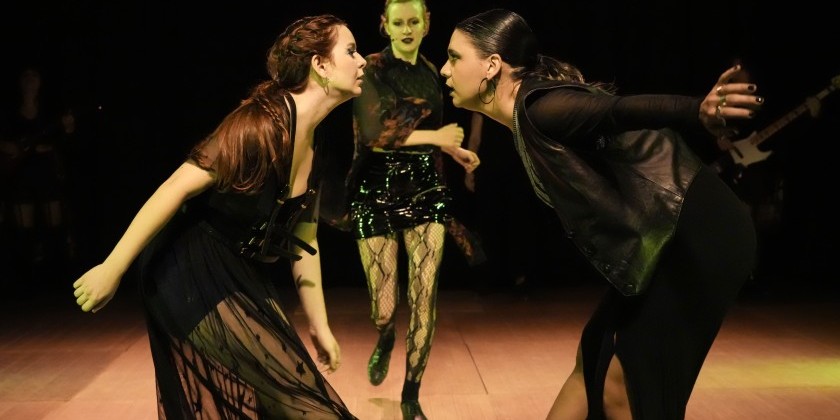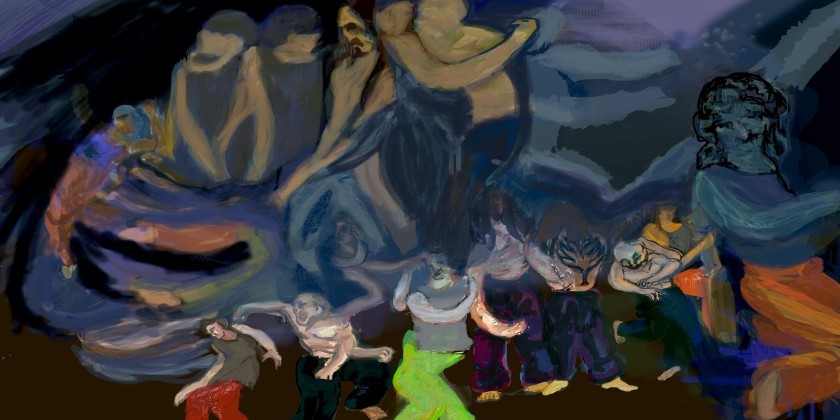AUDIENCE REVIEW: Alison Cook Beatty Dance at Ballet Hispánico

Company:
Alison Cook Beatty Dance
Performance Date:
November 3 & 4, 2017
Freeform Review:
Alison Cook Beatty Dance's latest performance showcase, "From Concept to Production: An Evening with Alison Cook Beatty Dance," was successfully presented to a full house at Ballet Hispánico on November 3 and 4, 2017. The audience was completely rapt and shaken by the deep, raw emotions expressed by the dancers' bold and honest movements, set to soul-stirring as well as uplifting music that they could sing along with.
The showcase featured four distinctively different dances, three of which were world premières. Along with dance performances, the audience was treated to an exhibition of artworks related to the choreographic processes, and an intimate Q&A session with Artistic Director Alison Cook-Beatty, all the company's dancers and guest performer Marlon Cherry.
The first dance was a solo by Ms Cook-Beatty named "Touched by Fire." Set to the music of Bach's Cello Suite in G Major, the first section was choreographed when she was still a student at the Boston Conservatory of Music at Berklee. The second section, set to Bach's Cello Suite No. 4 in E Flat Major, was newly added recently and premièred on November 3. Ms Cook-Beatty danced her solo in a bright red dress, evoking the flames of fire with her passionate, soaring moves, interspersed with contractions and head spinning that bordered reckless abandonment and madness.
In the second piece, a world première, which has exactly the same title and choreography but set to a different musical piece, "Into the Clouds" by contemporary composer Julia Wolfe, the audience witnessed a transformation in Ms Cook-Beatty's movement quality and were suddenly transported from a classical realm to the contemporary setting. It was fascinating to see how the same choreography matched two starkly different musical genres and still "worked"! The audience was spellbound by the end of the performance, when Ms Cook-Beatty self-rotated on the floor without music, seemingly in agony. The only thing audible was her breath, pulsating in the movement of silence.
As Ms Cook-Beatty explained in her introduction, the second version of this solo stemmed from an experiment of a new piece of music she came to be curious about during the reconstruction of her original choreography. The experiment happened spontaneously and was a kind of a "lucky accident."
The next dance, titled "The Emotions Project," also a world première, sprang from an interactive experiment that Ms Cook-Beatty did on Facebook about two months ago. She asked her audience what they considered to be the most vulnerable emotions. Responses poured in in the forms of words, phrases and pictures. Taking all the responses as clues, she then laid them all out on a huge "map," with arrows linking how one emotion morphs into another. This map was hung on the wall next to the stage as an exposition of her creative process.
During the rehearsals, Ms Cook-Beatty would challenge the dancers to make suggestions of movements that expressed these emotions. While she would give her own instructions on choreography, and craft off of their suggestions, the dancers were encouraged to express their individual interpretations and bring them on the stage. The result was an extremely intense demonstration of the full spectrum of human emotions in a capsule--from fear to anger, rejections, panic attack, desperation, shame, schadenfreude, to joy, forgiveness, peace and empathy.
As senior dancer Carolina Rivera told the audience later in the Q&A section, it was a big challenge to rehearse this dance, as dancers were invited to relinquish "control" and give in to the fluid and spontaneous interactions with their partners to come up with their unique interpretations of each emotion. Some of the emotions were particularly "shocking" to perform. For example, when newly hired dancer Nika Antuanette came to her first rehearsal, she immediately had to plunge into the dance of a panic attack!
Despite the wide range of emotions, this work gave an impression of unity and transcendence. The neo-baroque music, "Tenebrae" (version for string quartet), by renowned contemporary composer Osvaldo Golijov, along with the ethereal flowing quality of the costumes, made with white chiffon and copper-colored silk and designed by Ms Cook-Beatty herself and Barbara Carey, gave the impression of a classical Greek painting with different archetypes displayed with high drama. The performance literally took the audience's breath away.
The final work, "Houston Street Hootenanny," was a substantial production involving all company dancers, Ms Cook-Beatty herself and a guest percussionist, Marlon Cherry, an accomplished musician in his own rights.
Before the performance, Ms Cook-Beatty recounted the genesis of this piece. It all started with a vintage American flag that she was gifted. One day, she walked around Greenwich Village with this flag and her thoughts went to the Vietnam War era, when the anti-war movement, hippie culture and a lot of artistic creations sprouted in this part of New York City.
So she started to choreograph a dance using a suite of popular songs from the 1960's. This year, Ms Cook-Beatty worked with a sound editor and added in popular covers of some of these 60's songs. The fact that people are still singing the same songs some 50 years later was a point of fascination for her.
"The main reason I made all these changes to the piece, musically and choreographically this year, is I felt that with everything happening in today's society, this dance has the spirit to represent not just what happened in the past, but to speak out against what is happening now," explained Ms Cook-Beatty. "To ignore, turn a shoulder, or just not notice what is happening in today's world did not feel right. I could not put this dance up just about the 1960's. To me, my research began there, and in observing the world around me, people seem to be fighting for the same things in 2017. What's happening today may look or sound different from 1967, but the songs are the same. For example, Beyonce is singing the same song as Richie Havens'; Disturbed is singing the same song as Simon and Garfunkle, and so on."
To bring the 60's era to life, Company Manager and MC of the evening Tony Musco, who himself grew up in the 60s and has intimate connection to this era, designed costumes for the dancers to reflect the fashion of the time.
Cherry's participation in the piece was particularly interesting as his look resembles the famed guitarist Jimmi Henrix, who was a Vietnam War veteran himself and was active in Greenwich Village prior to his subsequent claim to fame in London, followed by the world.
Ms Cook-Beatty presented to the audience some black-and-white photographs from the Vietnam War era to show the sources of inspiration for her choreography. Dancers demonstrated the movements that reflected those images, including the hurling of war medals at the White House in protest of the war.
The performance started with a solemn, reflective dance about the war, set to "The Sound of Silence," followed by a gradual progression to the emotions of liberation with Joan Baez's "Te Ador/Ate Amanha" and "Plaisir d'Amor" and then different version of the song "Freedom" by Beyonce and various other artists as well as by the original singer Richie Havens. From then on, the audience was treated to visions of carefree, hippee youngsters celebrating sex, drugs and rock-and-roll along with the music of Bob Dylan's "Like a Rolling Stone" and the same song by Sleepers' Reign. The finale was an uplifting piece set to Peter, Paul and Mary's "If I Had A Hammer." There was an intricate story line in the dance but the audience was free to interpret whatever they read into it. While the subject matter is heavy and politically charged, the overall feel of the dance movements is light-hearted and a zeitgeist of one of the most transformative eras of modern-day American history.
The extraordinary performance brought down the whole house. Not only were audience members amazed by the sheer talent, sparkling presence and strength of the dancers--many of whom were classically trained, but were deeply touched by how the subject matter was handled with such great nuance and sensitivity. Some of the audience members who were involved or had family members who were involved in the Vietnam War participated in an animated discussion and congratulated the dance company for this excellent creation.
Both evenings concluded with lively Q&A sections with the company dancers, leaving the audience with a deeper understanding of the artistic process and a better appreciation of the dancers and the company as a whole. Dancer Dorrie Silver recounted how some of the songs she danced to were played constantly by her Vietnam War veteran father since the day she was born. So to dance to the music of the era holds a special meaning in her heart.
Kitty Lunn, Artistic Director of Infinity Dance Theater, commented after the show: "The work was spectacular and very, very interesting. The dancers are all fabulous movers and I'm very proud of Alison." Lunn enjoyed the whole evening's performance, but was particularly fascinated by the two versions of the solo that Ms Cook-Beatty danced. "I really liked the first piece, that she did the solo to the Bach, and then did it again to different music, and we saw how it changed her body. I really enjoyed that."
Stark Wilz, singer, songwriter and musician, who has been following Alison Cook Beatty Dance for years, said he enjoyed the performance very much. "I've seen as many performances as I could, and as many of the individual performances of any given engagement, and I have seen growth. It's very, very exciting. I love especially the mixture of modern with ballet technique, clearly, and a great deal of training on the part of the dancers. I thought this was a wonderful performance tonight." Wilz's favorite of the evening was "Houston Street Hootenanny" because, being a musician, he enjoyed the music set to the work, especially "If I Had a Hammer" by Peter, Paul and Mary. "Everyone was smiling and enjoying themselves both on the stage and in the audience."
— Louisa Wah
Photo credit: Russell Haydn/











